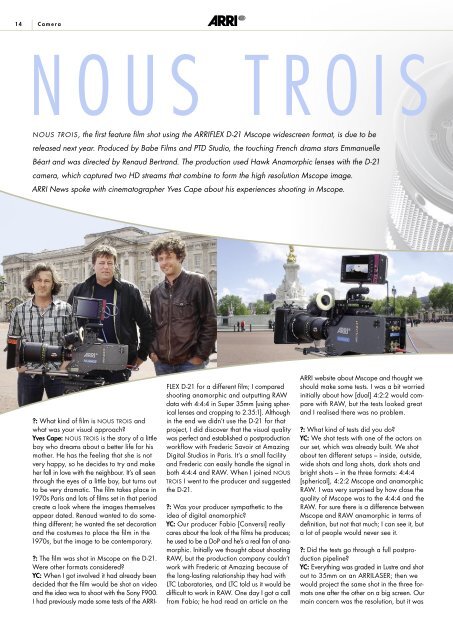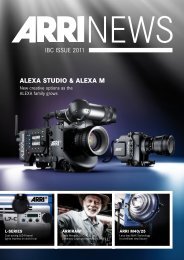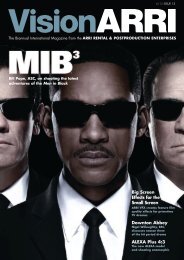ARRI News September 2009 - ARRI Media
ARRI News September 2009 - ARRI Media
ARRI News September 2009 - ARRI Media
Create successful ePaper yourself
Turn your PDF publications into a flip-book with our unique Google optimized e-Paper software.
14 Camera<br />
NoUS TRoIS<br />
NOUS TROIS, the first feature film shot using the <strong>ARRI</strong>FLEX D-21 Mscope widescreen format, is due to be<br />
released next year. Produced by Babe Films and PTD Studio, the touching French drama stars Emmanuelle<br />
Béart and was directed by Renaud Bertrand. The production used Hawk Anamorphic lenses with the D-21<br />
camera, which captured two HD streams that combine to form the high resolution Mscope image.<br />
<strong>ARRI</strong> <strong>News</strong> spoke with cinematographer Yves Cape about his experiences shooting in Mscope.<br />
?: What kind of film is NOUS TROIS and<br />
what was your visual approach?<br />
yves Cape: NOUS TROIS is the story of a little<br />
boy who dreams about a better life for his<br />
mother. He has the feeling that she is not<br />
very happy, so he decides to try and make<br />
her fall in love with the neighbour. It’s all seen<br />
through the eyes of a little boy, but turns out<br />
to be very dramatic. The film takes place in<br />
1970s Paris and lots of films set in that period<br />
create a look where the images themselves<br />
appear dated. Renaud wanted to do something<br />
different; he wanted the set decoration<br />
and the costumes to place the film in the<br />
1970s, but the image to be contemporary.<br />
?: The film was shot in Mscope on the D-21.<br />
Were other formats considered?<br />
yC: When I got involved it had already been<br />
decided that the film would be shot on video<br />
and the idea was to shoot with the Sony F900.<br />
I had previously made some tests of the <strong>ARRI</strong>-<br />
FLEX D-21 for a different film; I compared<br />
shooting anamorphic and outputting RAW<br />
data with 4:4:4 in Super 35mm [using spherical<br />
lenses and cropping to 2.35:1]. Although<br />
in the end we didn’t use the D-21 for that<br />
project, I did discover that the visual quality<br />
was perfect and established a postproduction<br />
workflow with Frederic Savoir at Amazing<br />
Digital Studios in Paris. It’s a small facility<br />
and Frederic can easily handle the signal in<br />
both 4:4:4 and RAW. When I joined NOUS<br />
TROIS I went to the producer and suggested<br />
the D-21.<br />
?: Was your producer sympathetic to the<br />
idea of digital anamorphic?<br />
yC: Our producer Fabio [Conversi] really<br />
cares about the look of the films he produces;<br />
he used to be a DoP and he’s a real fan of anamorphic.<br />
Initially we thought about shooting<br />
RAW, but the production company couldn’t<br />
work with Frederic at Amazing because of<br />
the long-lasting relationship they had with<br />
LTC Laboratories, and LTC told us it would be<br />
difficult to work in RAW. One day I got a call<br />
from Fabio; he had read an article on the<br />
<strong>ARRI</strong> website about Mscope and thought we<br />
should make some tests. I was a bit worried<br />
initially about how [dual] 4:2:2 would compare<br />
with RAW, but the tests looked great<br />
and I realised there was no problem.<br />
?: What kind of tests did you do?<br />
yC: We shot tests with one of the actors on<br />
our set, which was already built. We shot<br />
about ten different setups – inside, outside,<br />
wide shots and long shots, dark shots and<br />
bright shots – in the three formats: 4:4:4<br />
[spherical], 4:2:2 Mscope and anamorphic<br />
RAW. I was very surprised by how close the<br />
quality of Mscope was to the 4:4:4 and the<br />
RAW. For sure there is a difference between<br />
Mscope and RAW anamorphic in terms of<br />
definition, but not that much; I can see it, but<br />
a lot of people would never see it.<br />
?: Did the tests go through a full postproduction<br />
pipeline?<br />
yC: Everything was graded in Lustre and shot<br />
out to 35mm on an <strong>ARRI</strong>LASER; then we<br />
would project the same shot in the three formats<br />
one after the other on a big screen. Our<br />
main concern was the resolution, but it was





